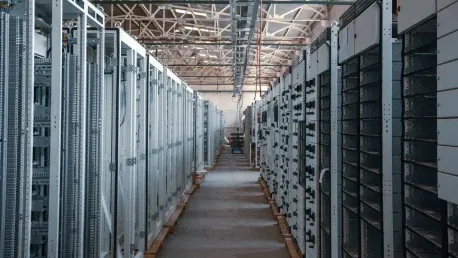The training of large-scale Large Language Models (LLMs) presents significant challenges due to increased computational and bandwidth demands. Traditional network architectures struggle to meet these requirements, emphasizing the need for innovation in AI data center design. Huawei researchers have introduced UB-Mesh, a novel network architecture designed to enhance scalability, efficiency, and reliability in AI data centers, specifically for LLM training.
The Challenges of Scaling LLM Training
Escalating Computational and Bandwidth Requirements
As LLMs scale, they require extensive computational power and bandwidth. Training models like LLAMA-3, which utilized 16,000 GPUs over 54 days, underscores the enormous resource needs. Traditional systems are pushed to their limits, unable to handle the interconnect bandwidth demands exceeding 3.2 Tbps per node. This unprecedented scale places immense stress on existing computational infrastructure, resulting in bottlenecks that hinder optimal performance and increase training duration.
The push for larger model parameters and data sets further exacerbates these issues. Enhanced comprehension, reasoning, and generation capabilities come at the cost of exponentially growing resource requirements. As AI data centers expand to encompass over 100,000 GPUs, the need for a scalable, effective infrastructure becomes more apparent. Conventional CPU-based systems are unfit to meet these demands, proving inadequate in both processing power and bandwidth capabilities. This stark contrast highlights the necessity for innovative architectural solutions capable of sustaining the rapid progress in AI technology.
Cost and Reliability Concerns in Traditional Architectures
Symmetrical Clos network architectures, used traditionally, are costly in both initial investment and ongoing operations such as energy consumption and maintenance. The substantial expenses involved in setting up these systems and maintaining operational efficiency pose significant financial burdens on organizations. Additionally, the high failure rate in large training clusters necessitates networks with robust fault tolerance, a pressing need not fully addressed by existing solutions. The constant risk of hardware failures demands continuous monitoring and quick mitigation strategies, further driving up costs.
High availability is another critical concern in traditional architectures. Large training clusters are prone to frequent hardware malfunctions, and ensuring seamless operation requires implementing highly fault-tolerant networks. The complexity involved in maintaining such networks often results in increased operational overhead. Efficient fault-tolerant mechanisms are essential to safeguard against data loss and maintain consistent performance. Therefore, addressing these challenges requires a fundamental rethinking of AI data center design, emphasizing cost-efficiency and reliability.
Redefining AI Data Center Architecture
Network Topologies and Traffic Patterns
A fundamental rethinking of design is required to meet these challenges. Effective network topologies must align with the structured traffic patterns intrinsic to LLM training, balancing tensor parallelism within small clusters and data parallelism over long distances with minimal communication. Tensor parallelism, involving the distribution of tensors across multiple processors, necessitates high-bandwidth, low-latency communication channels within clusters. Conversely, data parallelism, which partitions data across different nodes, requires managing long-distance communication efficiently, ensuring minimal delays.
By considering these intrinsic traffic patterns, a redesigned network architecture can optimize the flow of data, reducing congestion and enhancing overall system performance. This balanced approach ensures efficient resource utilization, mitigating bottlenecks and minimizing training times. It becomes evident that a one-size-fits-all solution is inadequate for the diverse requirements of LLM training, thus necessitating innovative network designs tailored to meet specific demands.
Co-Optimization and Fault Tolerance
Systematic co-optimization of computing and networking systems can prevent congestion and underutilization, emphasizing balanced resource distribution and efficient parallelism strategies. Seamless integration between computational and network resources ensures that data flows consistently without disruptions. This balance prevents idle resources and maximizes operational efficiency, effectively addressing the unique demands of large-scale LLM training. Utilizing effective parallel processing strategies and allocating resources dynamically can significantly improve performance.
Incorporating self-healing mechanisms into AI clusters ensures fault tolerance, adapting dynamically to reroute traffic and activate backup resources as needed. This proactive approach leverages redundancy to maintain system integrity, even in the face of hardware failures. Automatic rerouting minimizes downtime, ensuring that training processes continue uninterrupted. Such fault tolerance features are essential for maintaining high availability and reliability in large, complex network architectures. As a result, the implementation of these mechanisms provides a robust foundation for scalable, efficient AI data centers.
Introducing UB-Mesh Architecture
Innovation in Network Design: nD-FullMesh Topology
UB-Mesh introduces a cost-efficient, scalable network architecture built on a 4D-FullMesh topology. This innovative approach reduces dependence on switches and optical modules, utilizing a hierarchical, localized interconnect structure that facilitates communication while managing costs. Within UB-Mesh, a 2D full-mesh topology connects 64 NPUs within a single rack, creating tightly-knit clusters. These interconnected racks form a Pod, adhering to a 4D full-mesh configuration. SuperPods, which integrate multiple Pods, extend scalability further by employing hybrid Clos topologies. This multi-tiered design ensures efficient data transfer and streamlined communication, significantly enhancing overall performance.
By reducing reliance on traditional switches and optical modules, UB-Mesh lowers hardware expenses and operational costs. The hierarchical structure allows for flexible bandwidth allocation, optimizing communication across different components such as CPUs, NPUs, and switches. The Unified Bus (UB) interconnects modular hardware, enabling seamless integration and efficient data flow. This streamlined approach addresses the limitations of traditional architectures, ensuring scalability and efficiency in large-scale AI training setups.
Mechanisms of UB-Mesh: Routing and Fault Tolerance
Key to UB-Mesh’s effectiveness are features like All-Path Routing (APR), which enhances data traffic management through the network, and the 64+1 Backup System, which ensures redundancy and fault tolerance. The APR mechanism optimizes data transmission paths, reducing latency and preventing congestion. This dynamic routing strategy adapts to varying network conditions, ensuring consistent performance. The 64+1 Backup System further provides a robust safety net, automatically rerouting traffic to backup nodes in case of failures, ensuring uninterrupted operations.
The inclusion of a Collective Communication Unit (CCU) further optimizes data transfer and inter-NPU communication, reducing high-bandwidth memory consumption. Integrated within the UB IO controller, the CCU enhances collective communication, facilitating efficient data exchanges between NPUs. With in-line data reduction capabilities, the CCU minimizes memory overhead, optimizing resource usage and boosting performance. These fault-tolerant and data management features underscore UB-Mesh’s capacity for robust, reliable large-scale AI model training.
Performance and Efficiency
Hardware and Cost Reductions
Compared to traditional Clos networks, UB-Mesh significantly reduces hardware requirements, cutting down switch usage by 98% and optical modules by 93%. This architecture offers a cost efficiency improvement of over 2 times, maintaining performance with minimal compromises and introducing substantial cost-effective improvements for large-scale model training. The streamlined design lowers initial setup investments and ongoing operational expenses, presenting a financially viable option for organizations seeking scalable AI training solutions.
UB-Mesh’s architecture achieves these reductions by leveraging localized interconnects and modular hardware configurations. By minimizing the dependence on costly switches and optical modules, UB-Mesh lowers procurement and maintenance expenses. This cost-effectiveness does not come at the expense of performance, as the intelligent network design ensures optimal data flow and resource utilization. Consequently, UB-Mesh stands out as a compelling solution for organizations aiming to reduce expenditures while maintaining high-performance standards.
Optimized Communication Strategies
UB-Mesh supports optimized collective communication and parallelization strategies like the AllReduce Multi-Ring Algorithm, enhancing bandwidth and reducing data congestion. The multi-path approach facilitates increased data transmission rates for all-to-all communication, ensuring robust operational capacity and efficient performance. These strategies prioritize high-bandwidth configurations, optimizing data movement and minimizing communication delays. The AllReduce Multi-Ring Algorithm enhances throughput and mitigates bottlenecks, leveraging multiple communication paths for efficient data distribution.
By systematically searching for optimal parallelization conditions, UB-Mesh ensures efficient usage of available resources. This emphasis on maximizing bandwidth and minimizing congestion highlights the architecture’s efficiency. Comparing UB-Mesh with traditional network designs demonstrates its superior performance, showcasing its capability to handle large-scale LLM training without compromising on speed or accuracy. The strategic use of multi-path data transmission further underscores UB-Mesh’s proficiency in managing complex communication requirements.
Implications for Large-Scale LLM Training
Scalability and Availability
UB-Mesh presents a revolutionary architecture for scalable LLM training, offering over 95% linearity and a 7.2% improvement in availability. The design ensures that AI data centers can meet expansive training requirements while maintaining flexibility and affordability. This high degree of scalability allows organizations to expand their training capabilities seamlessly, accommodating growing data sets and model sizes. The improved availability guarantees consistent performance, minimizing downtimes and ensuring reliable operations.
This innovative architecture’s capability to deliver efficient performance at scale makes it ideal for large-scale AI training scenarios. It addresses the inherent challenges of resource allocation and fault tolerance, providing a robust solution for organizations working with extensive language models. By integrating scalable, cost-effective design principles, UB-Mesh meets both current and future needs of AI data centers, reinforcing its role as a pioneering solution in the industry.
Future-Proofing AI Data Centers
The training of large-scale Large Language Models (LLMs) brings considerable challenges due to the substantial demands on computational power and bandwidth. Traditional network architectures often fall short of meeting these heightened requirements, highlighting the necessity for innovation in designing AI data centers. Addressing this issue, Huawei researchers have developed UB-Mesh, a groundbreaking network architecture aimed at significantly improving scalability, efficiency, and reliability in AI data centers, specifically tailored for the demands of LLM training.
By overcoming the limitations of existing network setups, UB-Mesh offers a robust solution that ensures seamless and efficient operation. This novel design not only meets the rigorous demands of LLM training but also sets a new benchmark for future AI data center configurations. The introduction of UB-Mesh signifies a forward leap in how AI data centers handle the ever-growing needs of large-scale model training, ensuring that future advancements in AI can be supported and driven by more sophisticated and capable network architectures.









